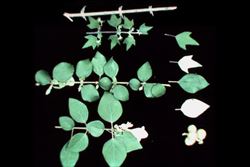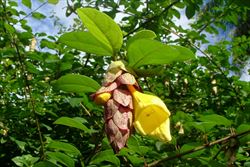Click on images to enlarge

infestation (Photo: Land Protection, QDNRW)

spiny stems, leaves, flowers and immature fruit (Photo: Land Protection, QDNRW)

flowers of parrot's beak (Gmelina philippensis), borne in an elongated cluster (Photo: Sheldon Navie)

the hairless leaf undersides of parrot's beak, Gmelina philippensis (Photo: Sheldon Navie)
Scientific Name
Gmelina elliptica Sm.
Synonyms
Gmelina asiatica L. (misapplied)Gmelina asiatica L. var. villosa (Roxb.) Bakh.Gmelina villosa Roxb.
Family
Verbenaceae (Northern Territory)Lamiaceae (New South Wales, Queensland and Western Australia)
Common Names
Asiatic beechberry, badhara bush, common bulang, oval-leafed gmelina, parrot's beak
Origin
Native to south-eastern Asia (i.e. Cambodia, northern Myanmar, Thailand, Vietnam, Indonesia, Malaysia and the Philippines) and some islands in the Indian (i.e. Mauritius, Andaman and Nicobar) and Pacific (i.e. Palau and Kiribati) Oceans.
Naturalised Distribution
This species is locally naturalised in central Queensland. It has also become naturalised overseas in Jamaica and Zaire.
Notes
Badhara bush (Gmelina elliptica) forms dense impenetrable thickets and it is regarded as an environmental weed in Queensland. This thorny shrub has significant impacts on natural areas, decreasing biodiversity and causing lasting environmental effects. It spreads mainly by bird-dispersed seeds, and was possibly deliberately introduced as a garden ornamental.
The only known infestations of Badhara bush (Gmelina elliptica) in Australia occur near Rockhampton (e.g. at Stanage Bay) and this species is currently the target of an extensive eradication program. However, it is a potential weed of wetter habitats throughout the tropical and sub-tropical regions of Australia, and is thought to pose a serious threat to rangeland biodiversity in northern Australia.

